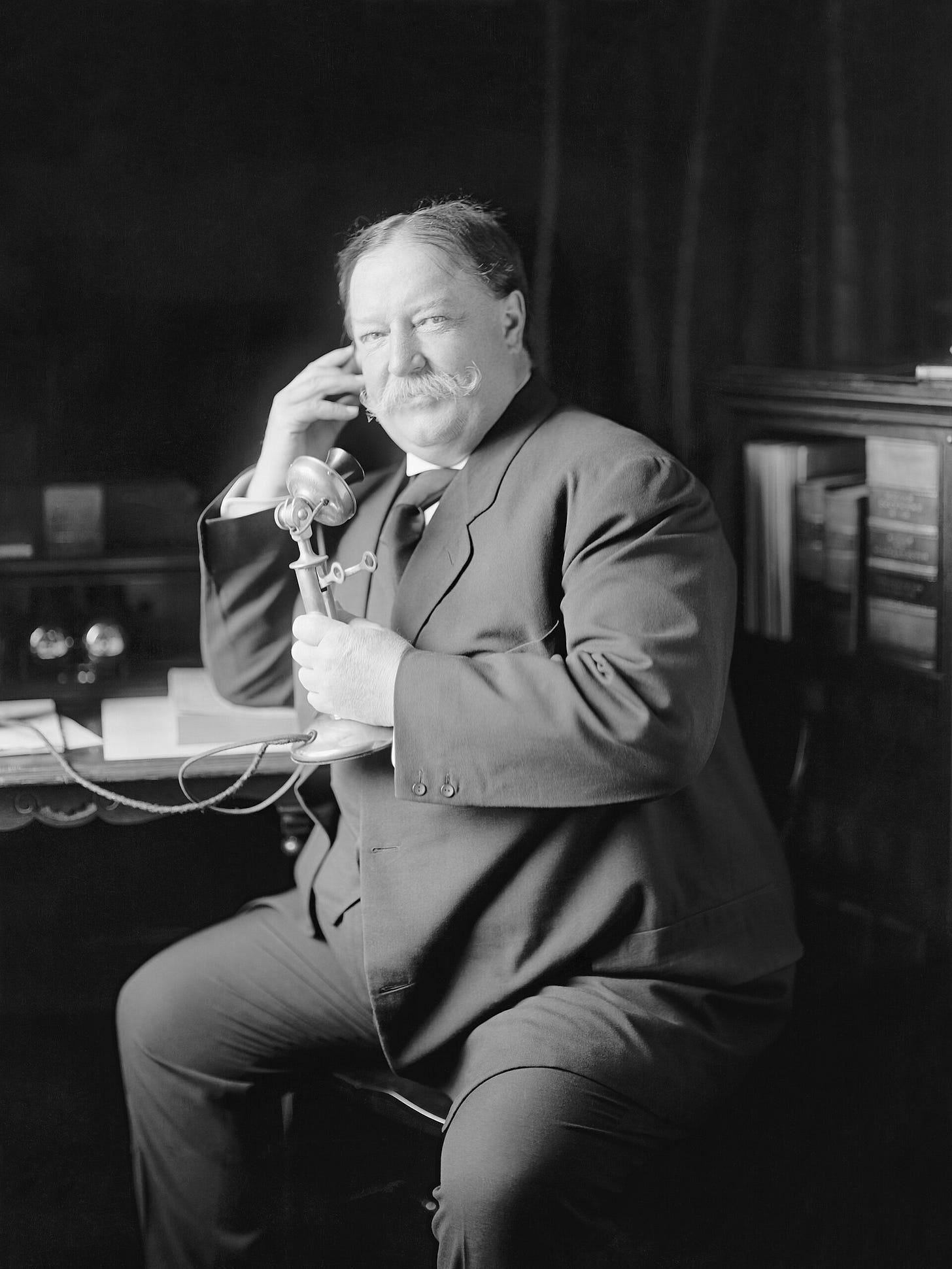This Day in Legal History: Expansion of US House of Representatives
On August 8, 1911, President William Howard Taft signed into law a measure that permanently expanded the size of the U.S. House of Representatives from 391 to 433 members. This change followed the 1910 census, which revealed significant population growth and shifts in where Americans lived. Under the Constitution, House seats are apportioned among the states according to population, and each decade’s census can lead to changes in representation. Prior to 1911, Congress often responded to new census data by simply adding seats rather than redistributing them among states. The 1911 legislation reflected both that tradition and the political realities of the time, as expanding the House allowed growing states to gain representation without forcing other states to lose seats. It also set the stage for the modern size of the House—just two years later, New Mexico and Arizona joined the Union, bringing the total to 435 members. That number has remained fixed by law since 1929, despite the nation’s continued population growth.
The 1911 increase carried implications beyond arithmetic: more members meant more voices, more local interests, and a larger scale for legislative negotiation. It also underscored Congress’s role in adapting the machinery of government to the country’s evolving demographics. In many ways, the expansion reflected Progressive Era concerns with fair representation and democratic responsiveness. While debates over House size have continued into the 21st century, the 1911 law remains a pivotal moment in the chamber’s institutional development. By enlarging the House, Taft and Congress preserved proportionality between population and representation, even if only temporarily.
After the 1911 increase under President Taft, the size of the House stayed at 435 members following Arizona and New Mexico’s statehood in 1912. The idea at the time was that future census results would continue to trigger changes, either by adding more seats or by redistributing them among the states.
But after the 1920 census, Congress ran into a political deadlock. Massive population growth in cities—and significant immigration—meant that urban states stood to gain seats while rural states would lose them. Rural lawmakers, who still held considerable power, resisted any reapportionment that would diminish their influence. For nearly a decade, Congress failed to pass a new apportionment plan, effectively ignoring the 1920 census results.
To end the stalemate, Congress passed the Permanent Apportionment Act of 1929. This law capped the House at 435 seats and created an automatic formula for reapportionment after each census. Instead of adding seats to reflect population growth, the formula reassigns the fixed number of seats among states. This froze the size of the House even as the U.S. population more than tripled over the next century.
Critics argue that the 1929 cap dilutes individual representation—today, each representative speaks for about 760,000 constituents on average, compared to roughly 200,000 in 1911. Supporters counter that a larger House would be unwieldy and harder to manage. The debate over whether to expand the House continues, but the 1929 law has held for nearly a hundred years, making Taft’s 1911 expansion the last time the chamber permanently grew in size.
A fourth federal court blocked President Donald Trump’s order restricting birthright citizenship, halting its enforcement nationwide. The order, issued on Trump’s first day back in office, sought to deny citizenship to children born in the U.S. unless at least one parent was a citizen or lawful permanent resident. Immigrant rights groups and 22 Democratic state attorneys general challenged the policy as a violation of the Fourteenth Amendment’s Citizenship Clause, which has long been interpreted to grant citizenship to nearly everyone born on U.S. soil.
U.S. District Judge Deborah Boardman in Maryland sided with the challengers, issuing the latest in a series of nationwide injunctions despite a recent Supreme Court ruling narrowing judges’ power to block policies universally. That June decision left a key exception: courts could still halt policies nationwide in certified class actions. Advocates quickly filed two such cases, including the one before Boardman, who had previously ruled in February that Trump’s interpretation of the Constitution was one “no court in the country has ever endorsed.”
In July, Boardman signaled she would grant national relief once class status was approved, but waited for the Fourth Circuit to return the case after the administration’s appeal was dismissed. Her new order covers all affected children born in the U.S., making it the first post–Supreme Court nationwide injunction issued via class action in the birthright fight. The case, Casa Inc. et al v. Trump, continues as part of a broader legal battle over the limits of presidential power in defining citizenship.
Fourth court blocks Trump's birthright citizenship order nationwide | Reuters
The Trump administration asked the U.S. Supreme Court to lift a lower court order restricting immigration enforcement tactics in much of Southern California. The Justice Department’s emergency filing seeks to overturn a ruling by U.S. District Judge Maame Frimpong, who barred federal agents from stopping or detaining individuals based solely on race, ethnicity, language, or similar factors without “reasonable suspicion” of unlawful presence. Her temporary restraining order stemmed from a proposed class action brought by Latino plaintiffs—including U.S. citizens—who alleged they were wrongly targeted, detained, or roughed up during immigration raids in Los Angeles.
The plaintiffs argued these tactics violated the Fourth Amendment’s protections against unreasonable searches and seizures, describing indiscriminate stops by masked, armed agents. Judge Frimpong agreed, finding the operations likely unconstitutional and blocking the use of race, ethnicity, language, workplace type, or certain locations as stand-alone reasons for suspicion. The Ninth Circuit declined to lift her order earlier this month.
The challenge comes amid a major escalation in Trump’s immigration enforcement push, which includes aggressive deportation targets, mass raids, and even the deployment of National Guard troops and U.S. Marines in Los Angeles—a move sharply opposed by state officials. The administration contends the restrictions hinder operations in a heavily populated region central to its immigration agenda. The Supreme Court will now decide whether to allow these limits to remain in place while the underlying constitutional challenge proceeds.
Trump asks US Supreme Court to lift limits on immigration raids | Reuters
Milbank announced it will pay seniority-based “special” bonuses to associates and special counsel worldwide, ranging from $6,000 to $25,000, with payments due by September 30. Milbank, of course, is among the big firms that bent to Trump’s strong-arm tactics, cutting a $100 million deal and dropping diversity-based hiring rather than risk becoming his next executive-order target. The New York-founded firm used the same bonus scale last summer, signaling optimism about high activity levels through the rest of the year. Milbank, known for setting the pace in Big Law compensation, is the first major corporate firm to roll out such bonuses this summer—a move that often pressures competitors to follow suit.
Special bonuses are not standard annual payouts, and last year rival firms mostly waited until year’s end to match Milbank’s mid-year scale, adding those amounts to their regular year-end bonuses. Milbank also led the market in November 2024 with annual bonuses up to $115,000. The firm is one of nine that reached agreements with President Trump earlier this year after his executive orders restricted certain law firms’ access to federal buildings, officials, and contracting work.
In a smaller but notable move, New York boutique Otterbourg recently awarded all full-time associates a $15,000 mid-year bonus, citing strong performance and contributions to the firm’s success.
Law firm Milbank to pay out 'special' bonuses for associates | Reuters
Milbank reaches deal with Trump as divide among law firms deepens | Reuters
A federal judge in North Dakota vacated the Federal Reserve’s rule capping debit card “swipe fees” at 21 cents per transaction, siding with retailers who have long argued the cap is too high. The decision, which found the Fed exceeded its authority by including certain costs in the fee calculation under Regulation II, will not take effect immediately to allow time for appeal. The case was brought by Corner Post, a convenience store that claimed the Fed ignored Congress’s directive to set issuer- and transaction-specific standards under the 2010 Dodd-Frank Act.
Banks, backed by groups like the Bank Policy Institute, defended the cap as compliant with the law, while retailers and small business advocates supported Corner Post’s challenge. This is Judge Daniel Traynor’s second ruling in the dispute; he initially dismissed the case in 2022 as untimely, but the U.S. Supreme Court revived it in 2024, easing limits on challenges to older regulations. An appeal to the Eighth Circuit is expected, with the losing side likely to seek Supreme Court review. The ruling comes as the Fed separately considers lowering the cap to 14.4 cents, a proposal still pending.
US judge vacates Fed’s debit card 'swipe fees' rule, but pauses order for appeal | Reuters
Texas-based Fintiv sued Apple in federal court, accusing the company of stealing trade secrets to develop Apple Pay. Fintiv claims the mobile wallet’s core technology originated with CorFire, a company it acquired in 2014, and that Apple learned of it during 2011–2012 meetings and nondisclosure agreements intended to explore licensing. According to the complaint, Apple instead hired away CorFire employees and used the technology without permission, launching Apple Pay in 2014 and expanding it globally.
Fintiv alleges Apple has run an informal racketeering operation, using Apple Pay to collect transaction fees for major banks and credit card networks, generating billions in revenue without compensating Fintiv. The suit seeks compensatory and punitive damages under federal and Georgia trade secret and anti-racketeering laws, including RICO. Apple is the sole defendant and has not commented.
The case follows the recent dismissal of Fintiv’s related patent lawsuit against Apple in Texas, which the company plans to appeal. The new lawsuit was filed in the Northern District of Georgia, where CorFire was originally based.
Lawsuit accuses Apple of stealing trade secrets to create Apple Pay | Reuters
This week’s closing theme is by Antonín Dvořák
This week’s closing theme comes from a composer who knew how to weave folk spirit into the fabric of high art without losing either warmth or polish. Dvořák, born in 1841 in what is now the Czech Republic, grew from a village-trained violist into one of the most celebrated composers of the late 19th century. His music often married classical forms with the rhythms, turns, and dances of his homeland—an approach that made his work instantly recognizable and deeply human.
His Piano Quintet No. 2 in A major, Op. 81, written in 1887, is a prime example. Dvořák had actually written an earlier piano quintet in the same key but was dissatisfied with it; rather than revise, he started fresh. The result is one of the most beloved chamber works in the repertoire. Across its four movements, the quintet blends lyrical sweep with earthy energy—romantic in scope, yet grounded in folk idiom. The opening Allegro bursts forth with an expansive theme, the piano and strings trading lines as if in animated conversation.
The second movement, marked Dumka, takes its name from a Slavic song form alternating between melancholy reflection and lively dance. Here, Dvořák’s gift for emotional contrast is on full display—wistful cello lines give way to playful rhythms before sinking back into introspection. The third movement is a Furiant, a fiery Czech dance bristling with syncopation and vigor, while the finale spins out buoyant melodies with an almost orchestral fullness.
It is music that feels both intimate and vast, as if played in a parlor with the windows thrown open to the countryside. With this quintet, Dvořák shows how local color can speak in a universal voice—how the tunes of a homeland can travel the world without losing their soul. For our purposes, it’s a reminder that endings can be celebratory, heartfelt, and just a bit homespun.
Without further ado, Antonín Dvořák’s Piano Quintet No. 2 in A major, Op. 81 – enjoy!














